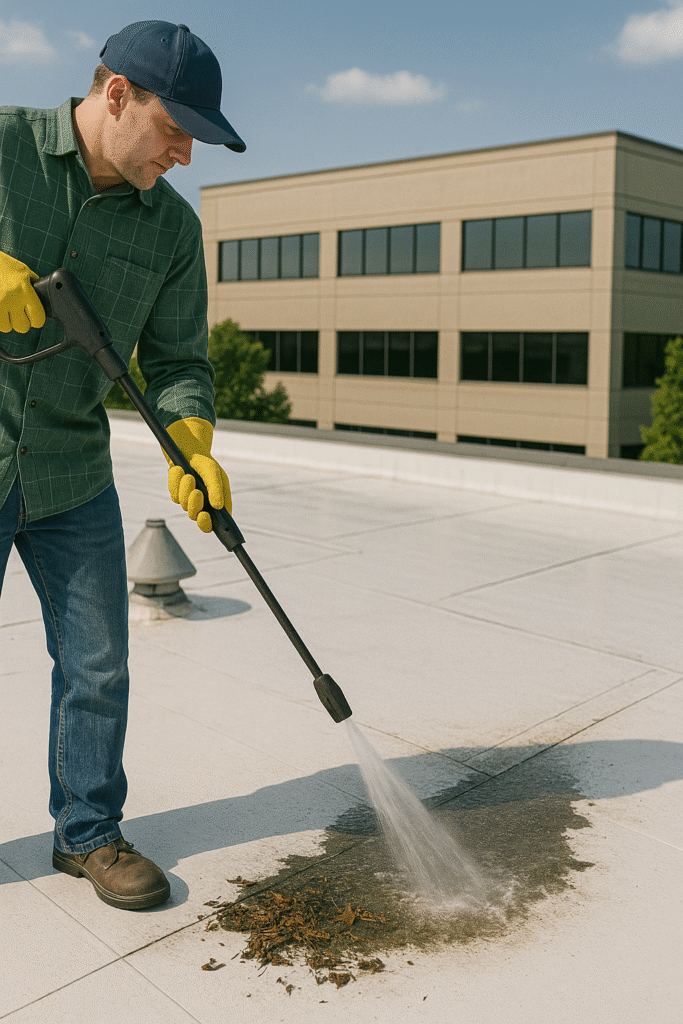Spring is often associated with spring cleaning as we emerge from the cocoon of winter. While it’s a great time to tidy up and organize the interior of your building, it’s also a good time for facilities managers to take an inventory of the outside of their building—particularly the roof. Here are some areas to consider for your spring cleaning roof checklist:
Remove Debris from Your Gutter System
Spring often brings rain, wind and storms as cold and warm fronts coalesce. Leaves, twigs and other debris can accumulate in your gutters causing them to not properly drain. If debris builds up over time, the excessive weight can cause gutters to loosen or possibly sag further causing improper water drainage. Be sure to check your building’s gutters and remove debris regularly to ensure proper removal of water from your roofing system and also away from your building’s façade and foundation. It’s also a good idea to trim trees that overhang the roof system to keep both the roof and gutters clear of debris.
Take Care of Active Leaks
The harsh winter weather conditions followed by spring storms—strong winds and hail—can create weather-related damage. If there’s lingering snow, as the weather warms up and temperatures rise and snow melts, roof leaks can become all too apparent.
Assess your building’s interior for water damage, particularly looking for stained ceilings or walls. The source of water intrusion may not always be obvious, and it may be necessary to engage a professional to conduct a forensic leak investigation to determine the source and subsequent remediation.
Assess Your Membrane
Freeze-thaw and the temperature fluctuation with the seasons can cause roofing components to expand and contract. This can lead to the weakening of your roof membrane. Cracks and blisters lead to splitting and separation that cause gaps in the membrane that then lead to water intrusion. Spring is the perfect time to take a moment to assess the overall wear-and-tear of your roofing system.
Check Your Seals and Flashing
Sealants are used to create a watertight barrier around rooftop penetrations. When temperature fluctuations cause expansion and contraction, this sealant can crack or warp over time. Dried out caulking, separation and lifting can cause gaps that lead to water infiltration from the roofing system and into the building interior. Metal flashing is typically made of materials like aluminum or galvanized steel which can erode, rust and wear over time. As the weather becomes nicer, it’s a good time to take a closer look at the sealant and flashing of your rooftop penetrations or hire a professional to do so.
Unclog Your Drains
Not all flat and low slope roofs utilize gutters to funnel water away from the building structure; some utilize rooftop drains. Like gutters, drains can become clogged with leaves, branches and debris from winter and spring storms. Clogged drains prevent water from exiting the rooftop, leading to ponding water and trapped moisture that can cause leaks in the interior of the building. Be sure to take the time to keep rooftop drains clear of debris.
If your spring cleaning reveals leaks or other concerns such as a damaged roof membrane, Technical Assurance can help you address and remediate these problems. With 30 years of building envelope and structural engineering consultation experience, we offer a comprehensive approach to preserve the life of your expensive assets.
Contact Us Today!
Technical Assurance can help you take a proactive approach to ensure optimal performance of your building envelope. Contact us today for a consultation and assure that your investment lasts well into the future.

